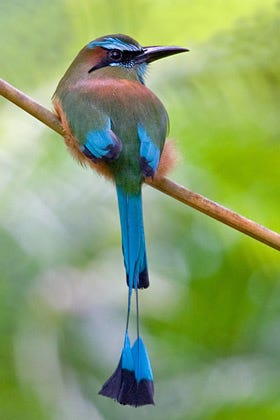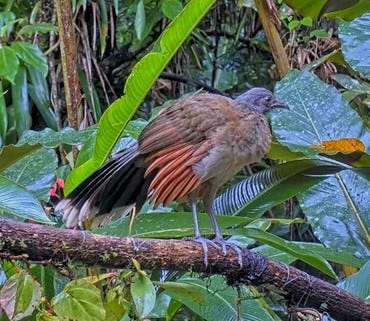
The company they keep
If you captured a songbird before it migrated and put it in a cage, you might be awakened by its nocturnal fluttering. This migratory restlessness—dubbed Zugunruhe by a German naturalist in the 1700s—has provided intriguing insights into bird migration. When scientists in the 1960s placed songbirds in a planetarium in funnel-shaped cages with an inkpad at the bottom, the birds left little inky tracks on one side of the paper-lined walls, as they fluttered in the direction that they would have migrated had they been free to fly. When the scientists rotated the planetarium’s “night sky” 180 degrees, the birds fluttered in the opposite direction, revealing that they used celestial cues (among others) to help them navigate during their nocturnal migration.
Each late summer, as I watch swallows gathering in great numbers on power lines, flocks of bluebirds roving across nearby fields, and loose aggregations of nighthawks flying over me at dusk, I feel that Zugunruhe and wish I could join the millions of birds that set out each night, heading for warmer climes. While we are sleeping, innumerable beating wings ply the starry skies high over our heads, as northern birds make their way to their winter homes.
October can be a sad time for those of us who are energized by the activities of our spring and summer birds. My mornings are quiet without the accompaniment of the meadowlark’s song. My outdoor vista sparkles a little less without the Mountain Bluebird’s flashy presence. The haunting calls of southward-flying geese are a harbinger of a lonelier season. But picturing the lives of our northern birds when they are in their winter haunts provides some consolation. Their dawns might be accompanied by the roaring calls of howler monkeys, the melodious song of the ubiquitous Clay-colored Thrush, or the frog-like cri cri cri of a Keel-billed Toucan. They may perch beside turkey-like chachalacas or feed alongside parrots. Theirs will be a world of motmots, trogons, and tanagers. And this is a world I love.
I was first introduced to the tropics and its birdlife in the mid-1990s when I went to Guatemala for the first time to study and conserve the beautiful Yellow-naped Amazon parrot. My Guatemalan colleague, Marco, delighted in showing me the avian gems that shared his home. One day, as we were leaving a parrot nest we’d been monitoring, we heard a croaking worohh worohh as we walked past a forested riparian area. “Motmot!” Marco announced, then dashed into the underbrush. I followed, pushing through the thick vegetation. Seconds later, Marco pointed. “There,” he said. I looked and saw nothing but greenery. But after a moment, I finally spied a subtle movement.
Below a branch, two colorful triangles swung gently to and fro, like the pendulum of an old-fashioned clock. I realized I was looking at the motmot’s tail rackets—the unmistakable ends of its two central tail feathers. And now I saw the partially obscured head and body of the magnificent turquoise, olive-green, black, and chestnut bird. My first Turquoise-browed Motmot—a tropical forest bird in the kingfisher and bee-eater family that feeds on insects, lizards, and fruit. I was bedazzled.
We were in a patch of what once had been a more extensive dry forest but had now been converted to cattle pastures. In the years to come, I’d spend time in wetter lowland rainforests, misty cloud forests, high-elevation grasslands, and a host of other tropical habitats. Habitats that were saturated with every imaginable shade of green; habitats that thrummed with insect life and dripped with moisture. I’d marvel at exotic blooms, and delight in the iridescent flash of hummingbirds with evocative names like sylphs, fairies, and sunbeams. And always, I’d be dazzled by the electric colors, captivating behaviors, and penetrating songs of tropical birds.
So when the color fades from my Montana landscape and snow falls softly around my home, I channel my Zugunruhe into thinking about the lives our summer birds are leading while I await their return. I might even tune into the Cornell Lab’s bird-feeding-station webcam in Panama for a momentary window into their world. Those Bananaquits and tanagers at the feeder might be less familiar to us, but for some of “our” birds, they’re as familiar as the chickadees and nuthatches in our northern habitats. And when I take a little time to relish the company our summer birds keep when they’re home away from home, I don’t feel their absence quite as much in my fall and winter world.
Take a small step to help birds
It’s easy to feel helpless in the face of habitat destruction and disappearing wildlife. But according to the US Fish and Wildlife Service, over 96 million people in North America watch birds. If each of us does something to help them, we may be able to reverse declining bird numbers.
Here are a few things you can do:
Many migrating birds navigate using celestial cues, which can be obscured by humanity’s night lighting. Migrating birds are also particularly attracted to non-blinking red and white lights, which can draw them away from their migration and into dangers like the sides of buildings. Minimize outdoor lighting as much as possible during the migration season. If you need night lighting for safety, consider using motion-sensing or down-pointing lights. Turning off nonessential indoor lighting helps too.
Migratory birds that appear in your yard in the morning have likely survived a long night flight and may be frantically refueling, making them less attentive to predators. So if you have an outdoor cat, consider keeping it inside during the morning hours until the birds have fed and are a little warier.
Take a moment to snip the rubber band securing the broccoli you buy at the supermarket, and cut other rubber bands or circular plastic items (like beverage six-pack holders) before throwing them away. This will help ensure that birds and other wildlife don’t inadvertently get entangled in our trash.
Watch a bird webcam. Gaining insights into the lives of birds is not only entertaining but can also make us feel more invested in their futures. There are innumerable options online. For example, you can watch puffins in Maine or tropical birds in Panama, condors in California or albatrosses in New Zealand.
Thank you for reading and thanks for all you do to help birds!
Until next time …
P.S. If you’d like to read a little more about my tropical field work, check out my new book Feather Trails—A Journey of Discovery Among Endangered Birds. If you’ve already read it, please consider writing a review on Amazon or Goodreads.






"The haunting calls of southward-flying geese are a harbinger of a lonelier season." A perfect sentence. I was immediately in that moment.
Oh that Motmot is gorgeous. Thanks for sharing the live bird cams links, Sophie. I've loved checking them out!